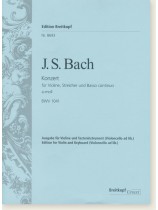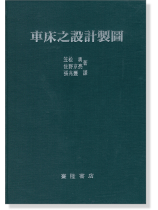J. S. Bach Konzert für Violine, Streicher und Basso Continuo a-moll BWV 1041 Edition for Violin and Keyboard (Violoncello ad lib.)
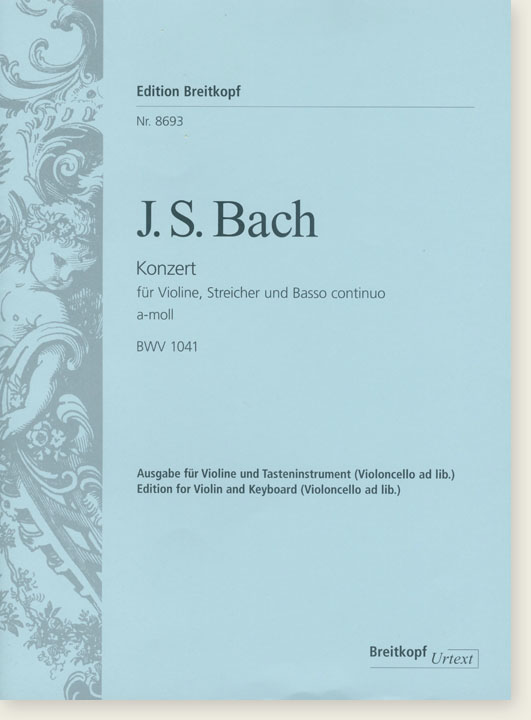
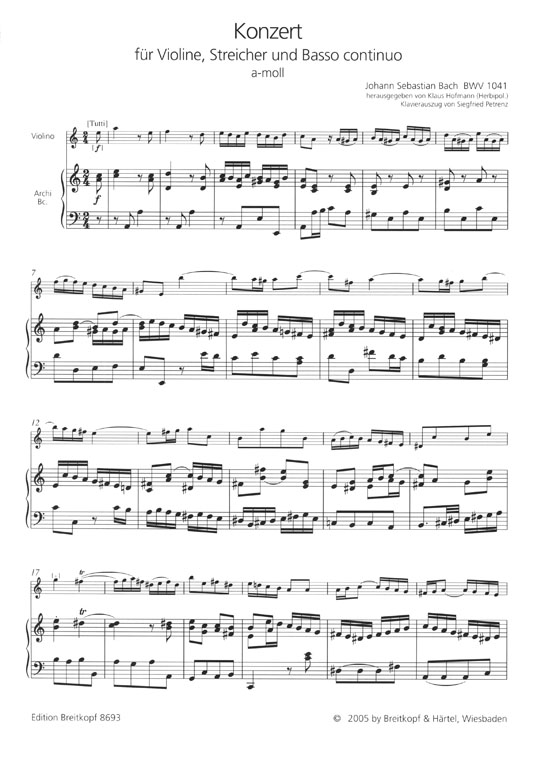
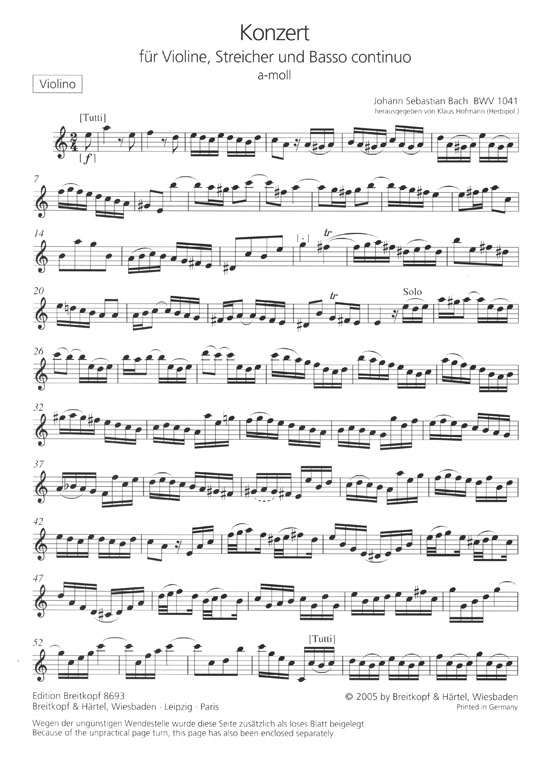



巴哈協奏曲獨奏與總奏的關係更為密切,更接近近代的協奏曲,採用快-慢-快的三樂章形式,使用數字低音伴奏,一般都以「第一號小提琴協奏曲」著稱,受義大利作曲家的強烈影響,樂曲具義大利風格的甜美,精巧無比的複曲調手法,也同時讓人感受到巴哈的嚴謹性。小提琴分譜+鋼琴伴奏譜(原典版)
- 庫存狀況: 缺貨
- 出版社: BREITKOPF & HARTEL
- 作者: Johann Sebastian Bach
- 編訂者: Klaus Hofmann
- 總書頁: 58
- 商品編號: 9790004182109
- ISBN: 9790004182109
簡介
The edition for violin and keyboard instrument (with continuo ad lib.) contains three violin parts (the first unmarked, the second with markings and comments by Sigiswald Kuijken, the third as a facsimile). This provides well-grounded stimuli for one’s own personal interpretation based on historically informed performance practice. The keyboard arrangement by Siegfried Petrenz is transparent and easy to play. A violoncello part has been added for chamber-music
The Violin Concerto in A minor BWV 1041 has been traditionally assigned by scholars to Bach’s years in Köthen (1717– 1723) as court Kapellmeister. This assumption cannot be justified by the work’s transmission, however, since Bach’s original score, which would be the most reliable witness, is lost. The only extant original source is a set of parts from Bach’s Leipzig period, c. 1730 (Staatsbibliothek zu Berlin, Mus. ms. Bach St 145), which was transcribed by Bach himself along with his son Carl Philipp Emanuel (1714–1788), his pupil Johann Ludwig Krebs (1713–1780) and two unidentified scribes. In spring 1729 the Thomaskantor had assumed the direction of the Leipzig Collegium musicum, which had been founded by Georg Philipp Telemann. The preparation of the parts is perhaps related to this activity.
Certain source findings do, however, give rise to the hypothesis that Bach did not compose the concerto at that time, but solely revised it. At various passages in the original parts – especially in the part of the second violin, first and second movements – we find corrected transcription errors which suggest a source in G minor. Moreover, Bach personally transcribed the third movement in five of the six parts. This points to an exceptional situation about which one can only speculate today: Perhaps the movement did not belong to the same source from which Bach’s fellow scribes had copied the first two movements; Bach thus might have replaced the original closing movement with one from another work, or possibly even wrote it from scratch. But it is also possible that he had made such far-reaching changes in the original closing movement that he did not trust his copyists to write out the parts from the heavily corrected score. We will never know.
Bach reworked the Violin Concerto in A minor into the Harpsichord Concerto in G minor (BWV 1058) around 1738. The autograph score of this version of the work is contained with other harpsichord concertos that originated from arrangements in the miscellany Mus. ms. Bach P 234 of the Staatsbibliothek zu Berlin. Strangely enough, the break-up of the lines in the score of the G-minor concerto corresponds to marks found in the music text of the original parts of the violin concerto in the form of dots placed above the staff. In preparing the score of the harpsichord arrangement, Bach possibly, and for reasons unknown to us, made use of the parts of the violin concerto instead of the original score, or in addition to it. At times one even finds errors from the part material in the score of the harpsichord concerto.
The present edition for violin and keyboard instrument is based on the source-critical new edition of the score (PB 5354) which is being published parallel to this volume. It basically follows the original set of parts St 145. Further information can be found in the “Revisionsbericht” of the edition of the score.
One particular problem is Bach’s setting of slurs. They are often imprecise, equivocal and inconsistent. Our depiction of the slurs can thus only be considered as an interpretive attempt that does not exclude other solutions. Additions made to the source text are indicated with brackets in the violin solo part; added slurs are printed in broken lines. The additions are based in general on the principle of analogy and are limited to this principle; they are far from aiming at being exhaustive. In order to let the performer make his own picture of the problem and to eventually let him develop his own solutions, we have enclosed a facsimile reproduction of the violin solo part from the original set of parts St 145 which stems from Bach's own hand.
One should note, however, that Bach’s slurring should not be read “literally”: according to recent findings,1 Bach’s slurs are generally too short. This concerns above all the slurs placed above the notes, which are often very high and appear to be shifted toward the left, but sometimes to the right as well. The lower slurs, in turn, are on the whole more precise in depicting what is actually intended, even if they often begin somewhat too much to the right. Bach, himself a violinist, apparently expected his performers to read his music “creatively,” as it were, and to modify the articulation spontaneously, wherever the bowing technique made this clear – a freedom that is obviously still a privilege of every violin soloist today.
We wish to extend our cordial thanks to the music division of the Staatsbibliothek zu Berlin – Preussischer Kulturbesitz for its permission to use its manuscripts. My particular thanks go out to Sigiswald Kuijken, whose advice helped me greatly in interpreting the slurs in St 145.
目錄
Song List:
- Violin Concerto in A minor BWV 1041
詳細規格
| 書籍資訊 | |
| 記譜法 | 五線譜(一般) |
| 原文語言 | 德文 |
| 特徵 | 西洋古典 |
| 樂器 | 小提琴 |
| 古典作曲家 | Bach J.S 巴哈(巴赫) |
| 時期與風格 | 巴洛克樂派 |
| 裝訂 | 平裝 |
| 形式 | 譜 |
| 外型尺寸 | 大於A4 樂譜常用尺寸 |

